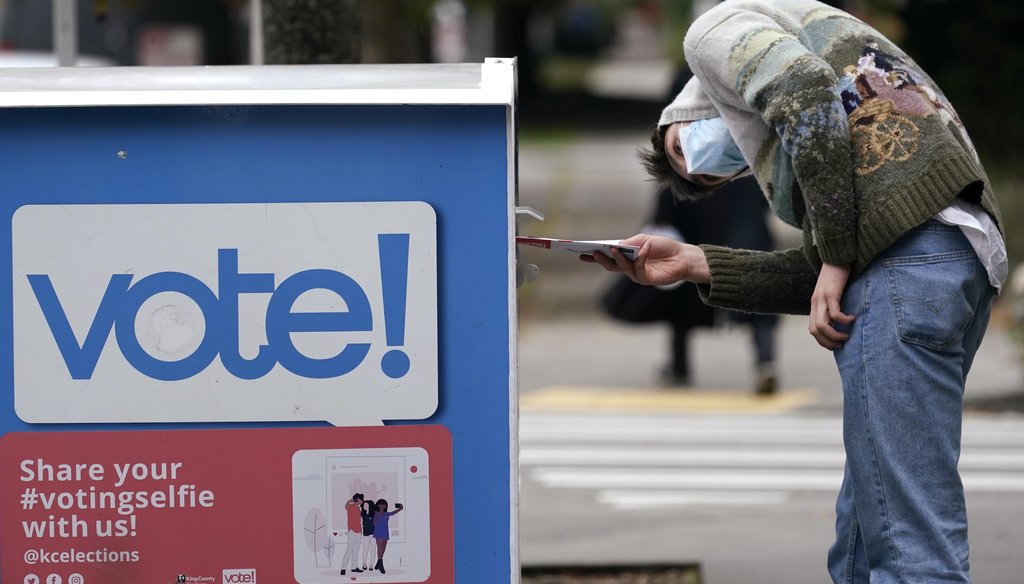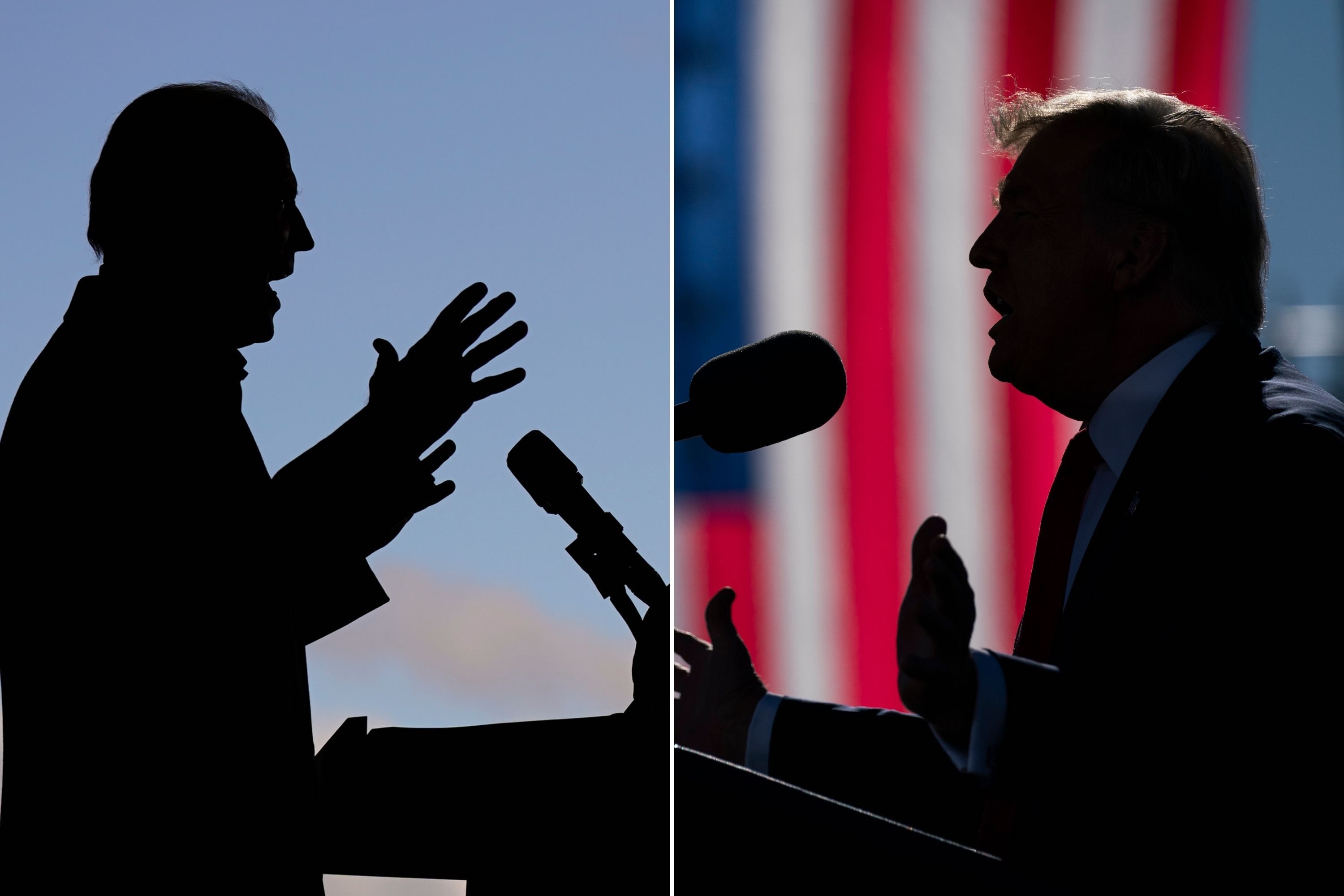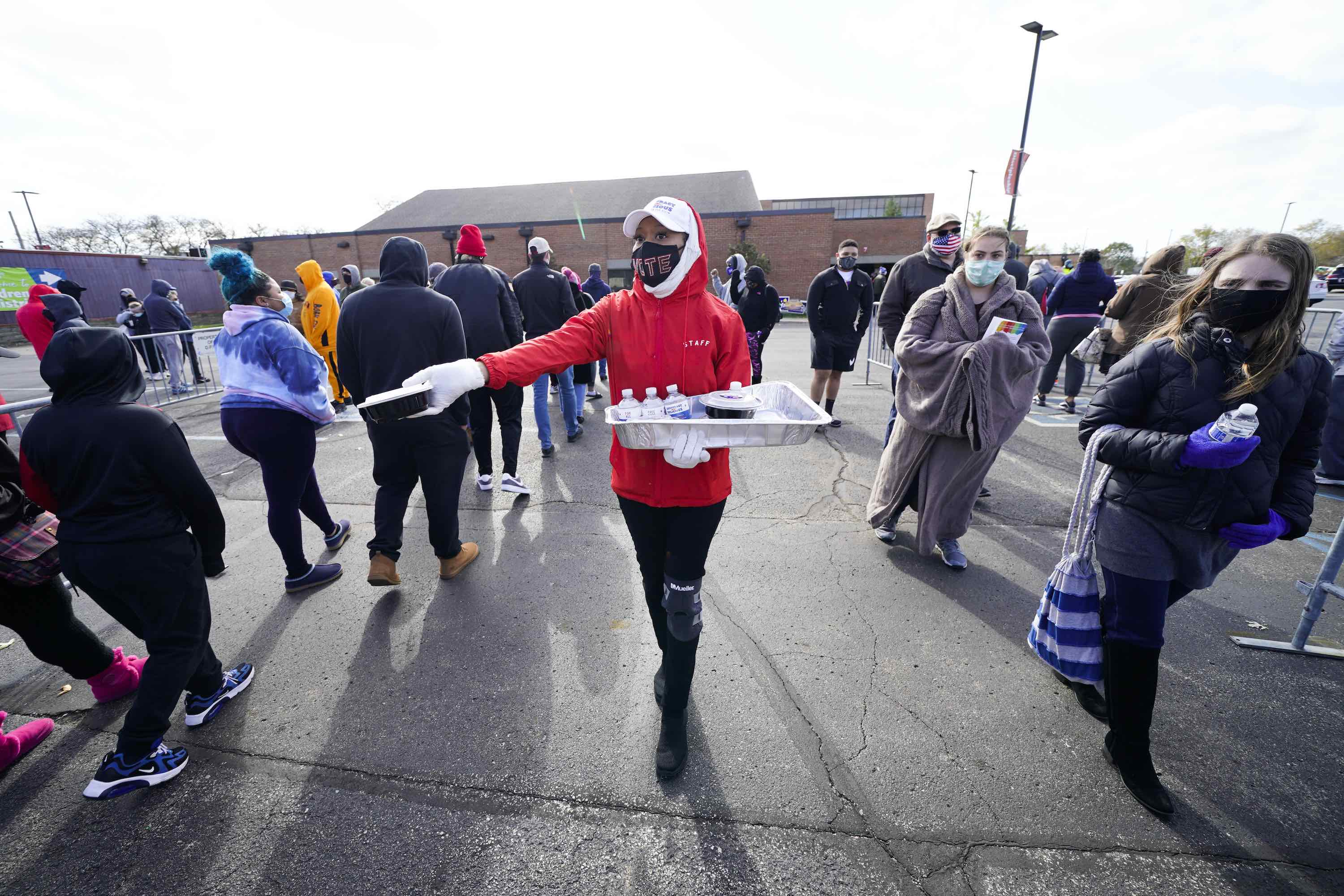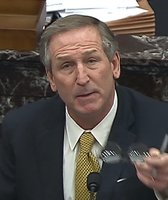Get PolitiFact in your inbox.

A voter eyes the opening of a ballot drop box before placing his ballot inside it on Oct. 28, 2020, in Seattle. (AP)
If Your Time is short
- At PolitiFact, we’ve been tracking claims about the voting process since the start of Democratic primary. Here are five things that will help you when you start seeing claims about voter fraud, voter intimidation, or about the results or the winners on Election Day.
An unprecedented level of mail-in and early voting in this year’s presidential election may also create an unprecedented level of misinformation.
As of Nov. 2, Americans had already cast nearly 100 million ballots — more than 70% of the total votes counted in 2016, according to data from the U.S. Elections Project. An influx of mail-in ballots and early voting, spurred by the coronavirus pandemic, could mean that Election Day turns into Election Week as poll workers race to count all the votes.
That delay in results, coupled with growing political polarization, could create a deluge of online misinformation that seeks to keep voters away from the polls or question the election outcome.
"I’m concerned that voters will hear disinformation telling them that voting is hard, or unsafe, or that their ballots won’t be counted correctly, or that their votes won’t matter," said David Becker, executive director of the Center for Election Innovation & Research, a nonprofit that aims to increase voter participation. "Nothing could be further from the truth."
At PolitiFact, we’ve been tracking claims about the voting process since the start of Democratic primary. Here are five things that will help you when you start seeing claims about voter fraud, voter intimidation, or about the results or the winners on Election Day.
This election will be weird
Election Day will look a little different this year — but that doesn’t necessarily mean something is wrong.
First, there’s a good chance that we may not know who wins the presidential election and other tight races Nov. 3. That’s because of the large amount of mail-in ballots cast this year.
Mail ballots take longer for election officials to count since they require additional verification, and some states are counting ballots that arrive after the polls close, as long as they’re postmarked before Election Day. This means that the "percentage of precincts reporting," a metric that indicates how many votes have been counted, will mean less this year than it has in the past.
Which leads us to Election Night. Because lots of ballots may not be counted right away, it’s possible and actually likely that early returns will look different from the final results.
RELATED: Prepare for the weirdest election 'night' ever
Democrats were more likely than Republicans to use mailed ballots or vote early, in part because President Donald Trump criticized some states for pursuing aggressive mail-in voting programs. So in states that don’t process mailed ballots before Election Day, such as Pennsylvania and Wisconsin, it’s likely that we’ll see more Republicans votes counted early (because Republicans are expected to vote more in-person on Nov. 3). More Democratic-leaning votes should be tallied later as more mail ballots get counted.
The opposite will play out in a state like Florida. Florida gets a head start in counting early and mail ballots, so Democrats might look like they’re winning out of the gate until in-person ballots start getting counted.
None of this would be evidence that there’s widespread voter fraud or ballot irregularities. It just reflects the order in which votes are counted and results are reported.
If you stay up late Nov. 3 and there still isn’t a declared winner by the national television networks or the Associated Press, don’t panic — that’s to be expected given the nature of holding an election during a pandemic.
Becker’s advice: "Be patient as the process of validating and counting every ballot proceeds, transparently, pursuant to state law."
Delayed results could spawn false claims
Since it’s likely to take longer to count ballots this year than in past elections, there will be plenty of room for partisans to make false claims about the results.
"Americans can no longer take for granted that election losers will concede a closely fought election after election authorities or courts have declared a winner," wrote a panel of election experts on restoring confidence in the 2020 elections. "Current American politics feature severe hyperpolarization and an increasingly partisan media and social media environment. Mistrust is high."
Given the probability that leads could swing from one candidate to another on Election Night as votes are tallied, some partisan websites or social media users may color in the map before all the votes are counted. Campaigns themselves may preemptively declare victory, casting doubt on the integrity of the election.
To avoid this kind of misinformation, create a plan for how you will keep up with results on Nov. 3. Choose a few nonpartisan news outlets that you trust, and stick with them for official vote tallies throughout the night. Be skeptical of sources that don’t explain the ballot-counting process, or those that don’t use phrases like "too early to call."
If you’d rather turn off the horse race coverage and wait until a winner is declared, consider turning to the Associated Press or TV networks for official election results. Those media organizations have "decision desks" that determine when there are enough results to call a race, and they don’t name a winner if the race is close or if only a fraction of the votes have been counted. In 2016, the AP was 99.8% accurate in calling election outcomes.
When in doubt, don’t take claims from social media or political campaigns at face value — there’s a good chance they will be a source of misinformation on Nov. 3.
Voter fraud is rare, but expect some hiccups
Trump has consistently tried to suggest — without evidence — that there is or will be widespread voter fraud due to the increase in mail-in ballots.
"There is no evidence that the 2020 general election will be affected by voter fraud," said Lorraine Minnite, a professor at Rutgers University-Camden and author of "The Myth of Voter Fraud."
According to a database maintained by the Heritage Foundation, a conservative think tank, there have been only a handful of voter fraud cases over the past few years. A 2007 report from the Brennan Center for Justice, a liberal public policy institute, found that Americans are more likely to be struck by lightning than impersonate someone else at the polls.
There’s evidence that mail-in ballots pose a slightly higher risk of voter fraud than voting in person, but we previously rated False a claim that "thousands and thousands" of people are conspiring to commit voter fraud through the mail. Those who commit voter fraud in a federal election could face up to five years in prison and a $10,000 fine.
RELATED: PolitiFact’s guide to finding good information on Election Night
"People should be wary of reports of voting problems, including voter fraud, that they see on social media," said Rick Hasen, a University of California-Irvine law professor who specializes in election law. "Some is deliberate misinformation, some reflects misunderstandings, and even the rare instances of voter fraud that are documented are usually so small as to have no appreciable effects on the election."
The best way to avoid falling prey to online misinformation about voter fraud is to slow down, open up a new browser tab on your phone or computer, and research the claims that you see or hear. If credible news organizations aren’t reporting that there’s widespread voter fraud, chances are there’s no evidence to support it. When in doubt, don’t share or repeat something you can’t confirm.
Finally, if you’re concerned about the security of your own mail ballot, the best thing you can do is check its status on your local elections website. If you see it hasn’t been counted by Election Day, you may be able to still vote in person.
Visuals may be used to cast doubt on voting
Photos show 1,000 mail-in ballots in a dumpster in California. A video depicts an election worker changing ballots in Maryland. A Democratic organizer is caught on camera telling people how to illegally vote in Arizona.
These are just a few examples of False, voting-related visuals that PolitiFact has debunked in the lead-up to Election Day — and we expect to see a lot more as votes are counted around the country.
"On Election Day itself, one category is the long lines videos, which are kind of complicated," said Ian Vandewalker, senior counsel for the Brennan Center’s Democracy Program. "A lot of people intend it to be inspirational or a criticism of the voter suppression idea, but obviously someone might see a video of a long line and say, ‘I’m not going.’"
People wait in lines outside a polling location while Pizza to the Polls food truck staff members deliver free food and snacks on Nov. 1, 2020, in Indianapolis. (AP)
While images of long lines at the polls may not necessarily be fabricated, they could be spread on social media with the intent of suppressing turnout. So if you see them in your feed, it’s important to take a look at the bigger picture.
The easiest way to learn about lines at your polling place is to follow local media outlets for updates or to visit those sites yourself. If there are lines, remember that they may look longer due to social distancing rules, and you can expect poll workers to try to move lines as quickly as possible.
On Election Day, you may also see photos or videos of armed individuals, some of whom may be members of local militias, that the Trump campaign and right-wing groups have encouraged to look out for fraud at the polls.
While cities in some states, like Florida, have increased security at polling places after receiving reports of armed people at polling places, these incidents may not be as widespread as they appear on social media. Voter intimidation is unlawful, and many states prohibit guns at polling places.
There could be misleading claims about violent protests
Given the potential delay in election results, coupled with lingering unrest from summer protests against police brutality, police departments and retailers nationwide are bracing for potential violence after Nov. 3. Partisans may try to blame extremist groups without evidence.
Take for example an article recently flagged by VineSight, an organization that uses artificial intelligence to surface potential misinformation. The story claims that "far-left groups" in Minnesota are planning "a violent coup attempt" should President Donald Trump win reelection.
The evidence cited in the article does not back that up — and it’s similar to claims that we debunked over the summer about left-wing extremist groups planning violence in towns across the country.
RELATED: 7 ways to avoid misinformation about the election
While there may be unrest in the days following Nov. 3, look out for social media posts that seem to go beyond what’s been confirmed about the situation.
Partisans have long blamed antifa, a loosely affiliated coalition of left-wing activists, or Black Lives Matter organizers for isolated incidents of violence or even natural disasters. But most antifa organizing is not rooted in physical violence, and the Black Lives Matter protests that spread nationwide earlier this year were largely peaceful. Criminal opportunists are usually to blame for rioting and looting that happens amid protests.
If violent protests do pop up near you on or after Election Day, look for updates from your local police department, sheriff’s office, and TV station or newspaper for the latest confirmed information. And most importantly, stay safe and take care of yourself — whatever happens on Nov. 3, the transition will likely be more contested than in past elections.
Our Sources
Agence France-Presse, "Fears of transition 'chaos' if Biden defeats Trump," Oct. 31, 2020
Associated Press, COUNTING THE VOTE
Axios, "Scoop: Trump's plan to declare premature victory," Nov. 1, 2020
Brennan Center for Justice, "The Truth About Voter Fraud," Nov. 9, 2007
CNN, "How to spot a red or blue 'mirage' in early election night results," Oct. 30, 2020
Email from David Becker, executive director of the Center for Election Innovation & Research, Nov. 1, 2020
Email from Lorraine Minnite, professor at Rutgers University-Camden and author of "The Myth of Voter Fraud," Nov. 1, 2020
Email from Rick Hasen, University of California-Irvine law professor, Nov. 1, 2020
Financial Times, "Rightwing poll ‘watchers’ plan to police US election," Oct. 24, 2020
The Heritage Foundation, Election Fraud Cases, accessed Nov. 1, 2020
Interview with Ian Vandewalker, senior counsel for the Brennan Center’s Democracy Program, Nov. 1, 2020
NBC News, "Trump accuses Democrats of 'rigging' the November election during Nevada rally," Sept. 13, 2020
The New York Times, "Armed Observers, Chants of ‘4 More Years’ at Polls: Is That Legal?" Oct. 30, 2020
NPR, "Trump's Calls For Poll Watchers Raise Fears About Voter Intimidation," Sept. 30, 2020
Pew Research Center, Political Polarization
PolitiFact, "Antifa activists did not start the West Coast wildfires," Sept. 10, 2020
PolitiFact, "Ask PolitiFact: What is antifa, and why is it all over my timeline?" July 2, 2020
PolitiFact, "Donald Trump’s dubious claim that 'thousands' are conspiring on mail-ballot fraud," April 9, 2020
PolitiFact, "Florida congressional candidate blames antifa for violence without evidence," June 26, 2020
PolitiFact, "How George Floyd protests evolved in 5 major cities," June 10, 2020
PolitiFact, "No, 'antifa' had no plans to raid wealthy Raleigh neighborhoods," June 5, 2020
PolitiFact, "Prepare for the weirdest election 'night' ever," Sept. 1, 2020
PolitiFact, "Trump spokesman Jason Miller paints dubious picture of Election Night," Nov. 1, 2020
PolitiFact, "White House press secretary McEnany takes Biden’s words on voter fraud out of context," Oct. 27, 2020
Tampa Bay Times, "What Florida democracy looks like in 2020 early voting," Oct. 28, 2020
Time magazine, "Trump’s Calls for an "Army" of Poll Watchers is Renewing Fears Of Voter Intimidation," Oct. 22, 2020
USA Today, "Stores brace for post-election unrest and possibility of violence, damage to businesses after presidential results," Nov. 2, 2020
U.S. Elections Project, 2020 General Election Early Vote Statistics, accessed Nov. 2, 2020
The Washington Post, "More than 91 million ballots cast as of Saturday, as hopes and tensions magnify ahead of Election Day," Oct. 31, 2020
The Washington Post, "Police brace for potential Election Day unrest in a year when ‘everything is uncertain,’" Oct. 24, 2020
The Washington Post, "Who caused the violence at protests? It wasn’t antifa." June 22, 2020
YouTube video from PolitiFact, "Do most states let you change your vote? No." Oct. 28, 2020




































